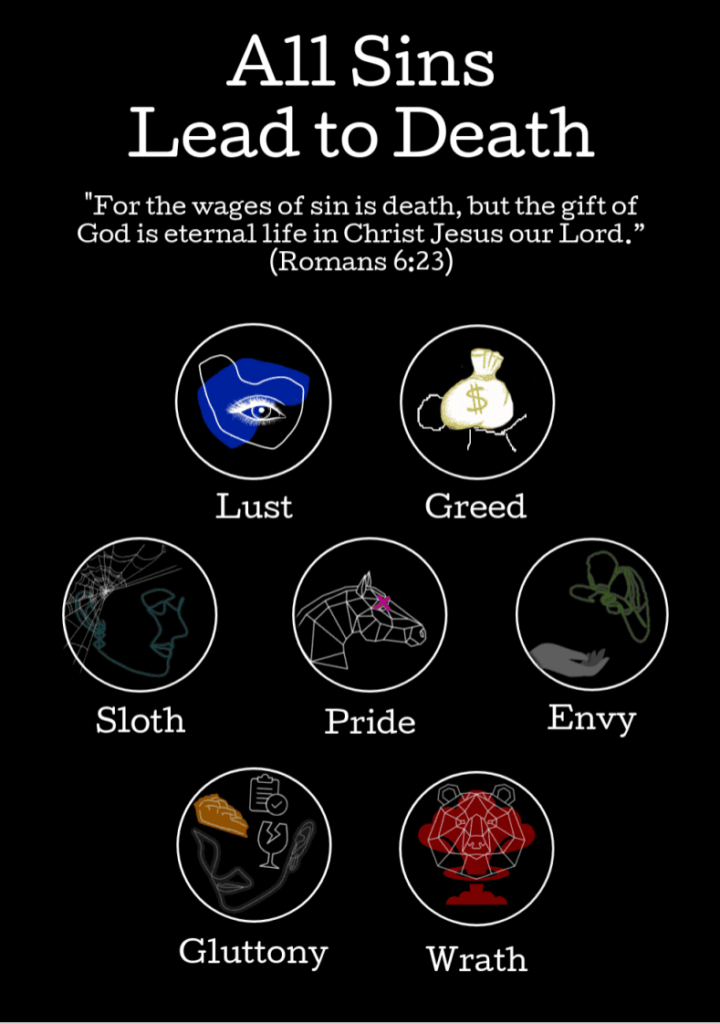The seven deadly Sins
A seven part movement series highlighting the personification of the Seven Deadly Sins & how they lead to death.

Historical context
According to Naveed Saleh on Psychology Today, the traditional seven deadly sins—as portrayed in Dante’s Inferno and Chaucer’s Canterbury Tales—include pride, envy, anger, sloth, greed, gluttony, and lust. Although this list has gone through various iterations in Christian liturgy, its foundations are more archetype than religious history. After all, the seven deadly sins are never clearly defined in the Bible.
Additionally, depictions of the seven deadly sins devoid of religious context are numerous in literature, film, poetry, and drama. Examples of these include but are not limited to the villians in Shazam!, Otto Dix’s die sieben todsünden, and even the main characters featured in Winnie the Pooh.
In the sixth century, the writings of Evagrius Ponticus influenced Pope Gregory I to come up with his own list that was later added to by St. Thomas Aquinas—resulting in the modern-day version of the seven deadly sins.
My artistic vision
In the beginning man was innocent of sin. In Genesis 2-3, we see that through the temptation of Satan, man transgressed the command of God, and inherited a nature and an environment inclined toward sin. Everyone sins. It’s human to constantly choose to go against God’s will for us. In Romans 6:23 it says, “For the wages of sin is death, but the gift of God is eternal life in Christ Jesus our Lord.” Considering that the definition of sin is a transgression against divine law and all sins lead to death, I was surprised to see while I was researching the Seven Deadly Sins and how others have portrayed them in media, that there were limited resources attached to the artwork about how to fight against sin.
I hope to continue researching and provide resources here on my website about how to fight against sin. So far I have been looking into the different spiritual disciplines that lead to focusing our thoughts and actions on God instead of things of this world.
Through creating these videos, I am adding myself into the artistic conversation about the Seven Deadly Sins with a spiritual perspective in mind. In each of the seven movement pieces I have created, I have developed a story that begins innocent then the person chooses to pursue a life of sin, and ends in death. I hope to portray how important it is to choose to follow God’s commands by visualizing the consequences of going against them.
Pride
Pride is a self-centered attitude where one is continually expecting or demanding praise and adulation.
CREDITS:
- Choreographed/Performed/Edited by Ariel Kraje
- Filmed by Sam Wells
- Song – Pride (Cinematic) by Amadeus
Greed
Greed is the powerful urge to take more than one’s fair share.
CREDITS:
- Choreographed/Performed/Edited by Ariel Kraje
- Filmed by Ariel Kraje
- Song – Timbres by Yosi Horikawa
Lust
Lust is an inordinate craving for the pleasures of the body.
CREDITS:
- Choreographed/Performed/Edited by Ariel Kraje
- Filmed by Ellie Fenerty
- Song – Dirty by Ida Laurberg
Envy
Envy is a painful or resentful awareness of an advantage enjoyed by another joined with a desire to possess the same advantage.
CREDITS:
- Choreographed/Performed/Edited by Ariel Kraje
- Filmed by Ellie Fenerty
- Song – (no copyright music) jazz type beat “bread” | prod. by lukrembo
Gluttony
Gluttony is addictive habits, like excessive or erratic eating and drinking, which cause oneself and others untold misery.
CREDITS:
- Choreographed/Performed/Edited by Ariel Kraje
- Filmed by Ariel Kraje, Sam Wells, and Savannah Barker
- Song – Gluttony Bay [church] by Goddard
Wrath
Wrath is an angry or resentful attitude reflected in feelings of strong or intense hostility, vengefulness, and inner rage.
CREDITS:
- Choreographed/Performed/Edited by Ariel Kraje
- Filmed by Ariel Kraje
- Song – Rain Dance (Marian HIll Remix) by Whilk & Misky
Sloth
Sloth is the disinclination to action or labor, spiritual apathy, and inactivity.
CREDITS:
- Choreographed/Performed/Edited by Ariel Kraje
- Filmed by Ariel Kraje
- Song – Work Song by Hozier
Look For the Good
Everyone expresses pain in a different way. Instead of dealing with it alone, we can use technology to stay connected. Look for the Good is an exploration of the Stages of Grief through movement.
Intrusive Thoughts
This piece was made for my final project in Great Film Performances at George Mason University.
The assignment was to make a silent, black-and-white film that expresses your inner self or some inner emotion inspired by any film we watched throughout the semester to emulate style, ie. Chaplin, Marx Bros, Screwball Comedy, Film Noir, Gangster, Western, etc.
Late
This piece was made for my final project in Great Film Directors at George Mason University.
The assignment was to make a silent film that expresses your inner self or some inner emotion inspired by any film we watched throughout the semester to emulate style.